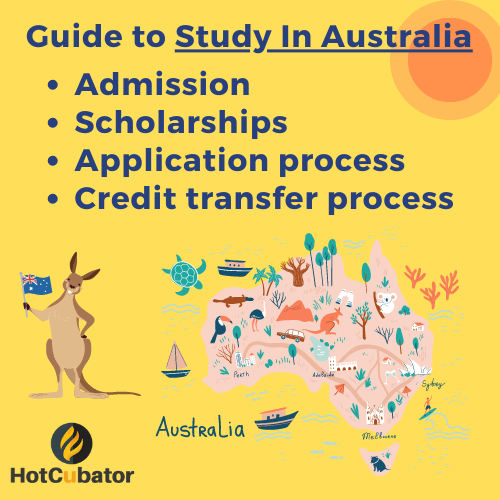
Studying in Australia as an international student can be a valuable and rewarding experience. The country boasts a high-quality education system, with many of its universities ranking among the best in the world. The multicultural society and diverse student population provide an inclusive and welcoming environment for international students. Additionally, the safe and stable environment, outdoor lifestyle, and professional opportunities make Australia an attractive destination for students. Additionally, the country offers a post-study work visa which allows international students to stay and work in Australia after completing their studies. Furthermore, Australian universities and colleges provide a lot of support to international students to help them settle in, find accommodation, navigate the cultural differences and succeed academically. With all these benefits, Australia is an ideal destination for students looking to gain a world-class education and an exciting experience.
Here are some key reasons why you can consider Australia as your higher study destination:
- High-quality education: Australia is home to some of the world’s best universities, which offer a wide range of academic programs and are known for their high-quality education and research.
- Multicultural society: Australia is a multicultural society, which means that international students will have the opportunity to interact and learn from people from a wide range of backgrounds.
- Safe and stable environment: Australia is known for its safe and stable environment, which makes it an attractive destination for international students.
- Outdoor lifestyle: Australia is known for its outdoor lifestyle, with many opportunities for students to enjoy outdoor activities such as hiking, surfing, and camping.
- Professional opportunities: Australia is a developed country with a strong economy and many opportunities for students to find work after graduation.
- Post study work visa: Australia offer a post-study work visa to international students which allows them to stay and work in the country after completing their studies.
- Supportive international student environment: Australian universities and colleges provide a lot of support to international students to help them settle in, find accommodation and part-time job, navigate the cultural differences and succeed academically.
- English speaking country: Australia is an English-speaking country which makes it an ideal destination for students who are looking to improve their English language skills.
Tuition fees:
The cost of studying in Australia as an international student can vary widely depending on the institution, level of study, and program. However, on average, the cost can be broken down as follows:
- Tuition fees: Tuition fees for international students in Australia can range from around $15,000 to $40,000 per year, depending on the institution and program.
- Living expenses: Living expenses in Australia can vary widely depending on the location, but on average, international students should expect to pay around $20,000 to $30,000 per year for accommodation, food, and other living expenses.
- Other costs: Other costs such as textbooks, equipment, and transportation should also be considered when budgeting for studying in Australia.
It’s important to note that some of the scholarships offered by universities and the government of Australia may cover some of these costs. It’s also important to check the visa requirements and the cost of the visa application.
It’s always a good idea to check the universities’ website and talk to their representatives for a more accurate estimate of the cost of studying at a specific university, as well as the availability of scholarships and financial aid.
Major Australian Scholarships for international students:
There are several major scholarships offered by Australian universities to international students, some of which include:
- Australian Government Research Training Program (RTP) Scholarships: Offered by the Australian government, these scholarships cover tuition fees and living expenses for international students undertaking a research-based masters or PhD degree.
- Endeavour Scholarships and Fellowships: These scholarships are offered by the Australian government and cover tuition fees, living expenses, and travel costs for international students undertaking a research or study program in Australia.
- University-specific scholarships: Many Australian universities offer their own scholarships to international students, often based on academic merit or financial need.
- Commonwealth scholarships: Commonwealth scholarships are offered to students from developing countries who wish to study in Australia, they are funded by the Australian government and the partner country.
- Destination Australia Scholarships: These scholarships are offered to international students to study in regional Australia, they are a part of the Australian government’s efforts to attract more international students to study in regional areas.
These are just examples, and the availability of scholarships may vary between universities and change over time, it’s always best to check the universities’ website for the most up-to-date information.
How to apply for scholarship to study in Australia
Great news is that Australia provides scholarships to international students. The Australian government, universities, and other organizations offer a wide range of scholarships to international students to help cover the costs of studying in Australia. Note that the availability of scholarships and their criteria vary, it’s always best to check the universities’ website and the Australian government’s website for more information on the scholarships available and their requirements. Here is a general guidance on the steps to study in Australia:
- Research scholarships: Look for scholarships that are available to international students and that align with your field of study and academic background.
- Check eligibility criteria: Make sure you meet the eligibility criteria for the scholarship you are applying for.
- Gather required documents: Collect all the necessary documents, such as transcripts, test scores, and letters of recommendation that are required for the scholarship application.
- Write a strong personal statement: Many scholarships require a personal statement, which is your chance to explain why you are the best candidate for the scholarship.
- Submit the application: Submit your completed application, along with all required documents, by the deadline.
- Follow up: After submitting your application, follow up with the scholarship provider to ensure your application has been received and is being processed.
Can international students work in Australia while studying?
International students are allowed to work in Australia while they are studying, however, there are some restrictions and regulations they must follow.
- The number of hours: International students on a valid student visa can work up to 40 hours per fortnight while their course is in session, and unrestricted hours during scheduled course breaks.
- Type of work: International students are only allowed to work in jobs that are related to their field of study or on-campus jobs.
- Minimum wage: International students must be paid at least the minimum wage for the work they do.
- Tax: International students must also pay taxes on any income they earn while working in Australia.
- Insurance: International students are required to have health insurance while studying in Australia, a condition of the visa.
It’s important to note that working while studying can have an impact on academic performance and student should be aware of that and balance their time and work accordingly. Also, it’s important to keep in mind the visa conditions and regulations, to make sure the student is compliant with the Australian immigration laws.
Top Australian universities:
Australia is home to many top-ranked universities, which offer a wide range of academic programs and are known for their high-quality education and research. Some of the top universities in Australia include:
- The University of Melbourne: Established in 1853, the University of Melbourne is the second oldest university in Australia and is consistently ranked among the top 50 universities in the world.
- The University of Sydney: Founded in 1850, the University of Sydney is the oldest university in Australia and is consistently ranked among the top 100 universities in the world.
- The Australian National University (ANU): Founded in 1946, ANU is a research-intensive university with a strong focus on science and technology.
- The University of Queensland: Founded in 1909, the University of Queensland is a research-intensive university with a strong focus on science, technology, engineering, and mathematics.
- Monash University: Founded in 1958, Monash University is a research-intensive university with a strong focus on science, technology, engineering, and medicine.
- The University of New South Wales (UNSW): Founded in 1949, UNSW is a research-intensive university with a strong focus on science, technology, engineering, and medicine.
- The University of Western Australia: Founded in 1911, the University of Western Australia is a research-intensive university with a strong focus on science, technology, engineering, and medicine.
These universities are just some examples of the many top-ranked universities in Australia, and all have a variety of academic programs, state-of-the-art facilities, and world-class research opportunities.
Credit transfer process in Australian Universities:
Transferring credit as an international student in Australian universities can be a complex process, but here are some general steps to follow:
- Research the institution: Research the institution you wish to transfer to, and ensure that they have similar programs to your current institution and that they will accept the credits you have earned.
- Check the transfer policy: Check the institution’s transfer policy and the specific requirements for transferring credit, as they may vary depending on the institution.
- Provide transcripts: Provide official transcripts from your previous institution, which should show the grades and credits you have earned.
- Provide course descriptions: Provide detailed course descriptions of the classes you have taken, including the course objectives, content, and assessment methods.
- Check for credit equivalency: Check if the institution you are transferring to have a credit equivalency system that allows you to match the courses you have taken with the courses offered by the institution
- Meet with an advisor: Meet with an academic advisor at the institution you wish to transfer to, to discuss your credit transfer options and to ensure that the credits you have earned will transfer.
- Complete the application: Complete the application process and submit all required documents, including transcripts, course descriptions, and any other required materials, by the deadline.
It’s important to note that each institution may have different policies and requirements, so it’s always best to check with the institution you’re transferring to for their specific requirements.
More resources:
https://www.studiesinaustralia.com/
https://www.internationalstudent.com/study_australia/
https://www.studyaustralia.gov.au/






